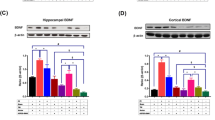Abstract
Recent evidences revealed that the alteration of microRNAs (miRNAs) might be associated with neuroplasticity induced by voluntary running wheel (RW) exercise in mice suffered from traumatic brain injury (TBI). In the present study, we explored the possible role of miR21 involved in the cognitive improvement following voluntary RW in TBI mice. Firstly, in situ hybridization and quantitative real-time PCR (qRT-PCR) were employed to determine the hippocampal expression and location of miR21 in TBI mice with or without spontaneous RW. Either miR21-mimics/plenti-miR21 or miR21-agomir/miR21-sponge was employed to regulate the miR21 expression in vivo and in vitro. Acquisition of spatial learning and memory retention was assessed by Morris Water Maze (MWM) test. Golgi stain was also performed to evaluate the alteration of hippocampal dendrite. Our finding confirmed that the elevated miR21 level in hippocampal post-TBI was significantly reduced by spontaneous RW. Overexpression of miR21 in TBI mice with spontaneous RW induced deteriorations in spatial learning and memory retention by significant decreases in the somata size and branch points of the hippocampus neurons. In vitro transduction with miR21 also reduced the neurite extension and the area of cultured hippocampal neuron. However, miR21 down-regulation reversed these effects. The present data strongly suggest that miR21 is an important molecule that has been involved in neuroprotection induced by voluntary RW exercise post-TBI.





Similar content being viewed by others
References
Baek SS, Jun TW, Kim KJ, Shin MS, Kang SY, Kim CJ (2012) Effects of postnatal treadmill exercise on apoptotic neuronal cell death and cell proliferation of maternal-separated rat pups. Brain Dev 34:45–56
Bao TH, Miao W, Han JH, Yin M, Yan Y, Wang WW, Zhu YH (2014) Spontaneous running wheel improves cognitive functions of mouse associated with miRNA expressional alteration in Hippocampus following traumatic brain injury. J Mol Neurosci 54:622–629
Bhalala OG, Pan L, Sahni V, McGuire TL, Gruner K, Tourtellotte WG, Kessler JA (2012) MicroRNA-21 regulates astrocytic response following spinal cord injury. J Neurosci 32:17935–17947
Dikmen SS, Corrigan JD, Levin HS, Machamer J, Stiers W, Weisskopf MG (2009) Cognitive outcome following traumatic brain injury. J Head Trauma Rehabil 24:430–438
Ebert MS, Neilson JR, Sharp PA (2007) MicroRNA sponges: competitive inhibitors of small RNAs in mammalian cells. Nat Methods 4:721–726
Filipowicz W, Bhattacharyya SN, Sonenberg N (2008) Mechanisms of post-transcriptional regulation by microRNAs: are the answers in sight? Nat Rev Genet 9:102–114
Griesbach GS, Hovda DA, Gomez-Pinilla F (2009) Exercise-induced improvement in cognitive performance after traumatic brain injury in rats is dependent on BDNF activation. Brain Res 1288:105–115
Gu YL, Zhang LW, Ma N, Ye LL, Wang-de X, Gao X (2014) Cognitive improvement of mice induced by exercise prior to traumatic brain injury is associated with cytochrome c oxidase. Neurosci Lett 6:86–91
Heo YM, Shin MS, Lee JM, Kim CJ, Baek SB, Kim KH, Baek SS (2014) Treadmill exercise ameliorates short-term memory disturbance in scopolamine-induced amnesia rats. Int Neurourol J 18(1):16–22
Hoffman AN, Krigbaum A, Ortiz JB, Mika A, Hutchinson KM, Bimonte-Nelson HA, Conrad CD (2011) Recovery after chronic stress with in spatial reference and working memory domains: correspondence with Hippocampal morphology. Eur J Neurosci 34:1023–1030
Itoh T, Imano M, Nishida S et al (2011) Exercise inhibits neuronal apoptosis and improves cerebral function following rat traumatic brain injury. J Neural Transm 118:1263–1272
Jaslove SW (1992) The integrative properties of spiny distal dendrites. Neuroscience 47:495–519
Kim SE, Ko IG, Kim BK et al (2010) Treadmill exercise prevents aging-induced failure of memory through an increase in neurogenesis and suppression of apoptosis in rat hippocampus. Exp Gerontol 45:357–365
Kim SE, Ko IG, Park CY, Shin MS, Kim CJ, Jee YS (2013) Treadmill and wheel exercise alleviate lipopolysaccharide-induced short-term memory impairment by enhancing neuronal maturation in rats. Mol Med Rep 7:31–36
Loane DJ, Pocivavsek A, Moussa CE et al (2009) Amyloid precursor protein secretases as therapeutic targets for traumatic brain injury. Nat Med 15:377–379
Long JM, Lahiri DK (2011) Current drug targets for modulating Alzheimer’s amyloid precursor protein: role of specific micro-RNA species. Curr Med Chem 18:3314–3321
Ntanasis-Stathopoulos J, Tzanninis JG, Philippou A, Koutsilieris M (2013) Epigenetic regulation on gene expression induced by physical exercise. J Musculoskelet Neuronal Interact 13:133–146
Redell JB, Zhao J, Dash PK (2011) Altered expression of miRNA-21 and its targets in the hippocampus after traumatic brain injury. J Neurosci Res 89:212–221
Rosi S, Belarbi K, Ferguson RA et al (2012) Trauma-induced alterations in cognition and Arc expression are reduced by previous exposure to 56Fe irradiation. Hippocampus 22:544–554
Stefani G, Slack FJ (2008) Small non-coding RNAs in animal development. Nat Rev Mol Cell Biol 9:219–230
VanLeeuwen JE, Petzinger GM, Walsh JP, Akopian GK, Vuckovic M, Jakowec MW (2010) Altered AMPA receptor expression with treadmill exercise in the 1-methyl-4-phenyl-1,2,3,6-tetrahydropyridine-lesioned mouse model of basal ganglia injury. J Neurosci Res 88:650–668
Wibrand K, Panja D, Tiron A et al (2010) Differential regulation of mature and precursor microRNA expression by NMDA and metabotropic glutamate receptor activation during LTP in the adult dentate gyrus in vivo. Eur J Neurosci 31:636–645
Acknowledgments
We thank Dr. Kevin J. Wells for his valuable comments during the preparation of this manuscript. This work is supported by National Natural Science Foundation of China (Grant NO.81100911, http://isisn.nsfc.gov.cn/egrantweb/), the Special Fund of the Applied Basic Research Programs of Yunnan Province associated with Kunming Medical University in China (Grant NO.2013FB116, http://61.166.241.213/). The funders had no role in study design, data collection and analysis, decision to publish, or preparation of the manuscript.
Conflict of Interest
The authors declare that they have no competing interest.
Author information
Authors and Affiliations
Corresponding author
Additional information
Tao Hu, Feng-Jie Zhou and Ye-Fei Chang contributed equally to this work.
Rights and permissions
About this article
Cite this article
Hu, T., Zhou, FJ., Chang, YF. et al. miR21 is Associated with the Cognitive Improvement Following Voluntary Running Wheel Exercise in TBI Mice. J Mol Neurosci 57, 114–122 (2015). https://doi.org/10.1007/s12031-015-0584-8
Received:
Accepted:
Published:
Issue Date:
DOI: https://doi.org/10.1007/s12031-015-0584-8




